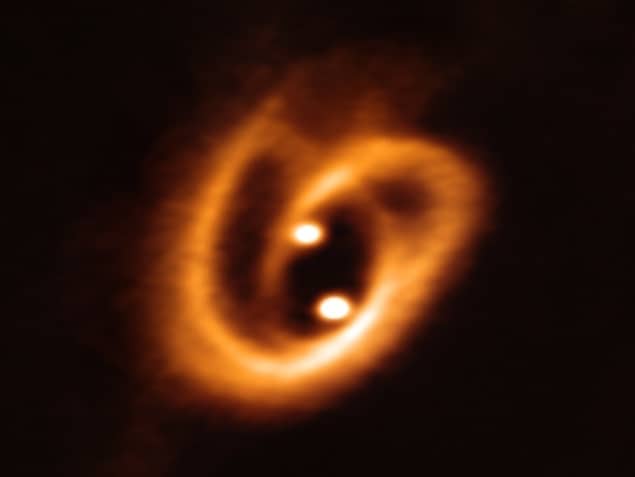
The above image shows two baby stars as they feed on a cosmic pretzel. Each star is surrounded by a circumstellar disc of dust and gas. Those discs are the two bright spots in the image and each disc is has a radius similar to the distance from the Sun to the asteroid belt. The distance between the stars is about 28 times the Sun-Earth distance.
The twisted filaments surrounding the two discs are also dust and gas that is feeding the two stars. The image was taken by the Atacama Large Millimeter/submillimeter Array of radio telescopes, which is operated by the European Southern Observatory.
You can read more about how this remarkable image is shedding new light on star formation in “A cosmic pretzel”.
Astonishing claim
“Nuclear fusion has become his graphene”. It’s not every day that physics features in the endless political debate going on in the UK – but this quip made on BBC Radio 4 by the columnist Polly Toynbee made me chuckle. She was referring to the astonishing claim by the British prime minister that nuclear fusion will provide clean energy by 2040.
Clearly Boris Johnson didn’t get the memo that fusion energy is always at least 30 years away and his 20-year claim has left some UK fusion scientists puzzled. Writing in The Conversation Thomas Nicholas at the University of York explains why “Conservatives’ ‘nuclear fusion by 2040’ pledge is wishful thinking”.
The graphene part of Toynbee’s quip is a reference to the former Conservative politician and chancellor of the exchequer George Osborne. He was very keen on the ultrathin material — possibly because it was invented in Manchester, which is the epicentre of his “Northern Powerhouse”.
Next up is a more plausible claim – that there is a primordial black hole orbiting the Sun. Jakub Scholtz of the University of Durham and James Unwin at the University of Illinois say that the gravitational tug of a tiny black hole – about 5-10 Earth masses – could explain the oddly-clustered orbits of objects beyond Neptune. Another possible explanation for this clustering is the existence of ‘Planet 9’ a similarly-sized planet in a huge and eccentric orbit.
But Planet 9 has not been observed directly, so Scholtz and Unwin reckon that a black hole the size of a bowling ball could be the invisible culprit. They set-out their argument in “What if Planet 9 is a Primordial Black Hole?”.



